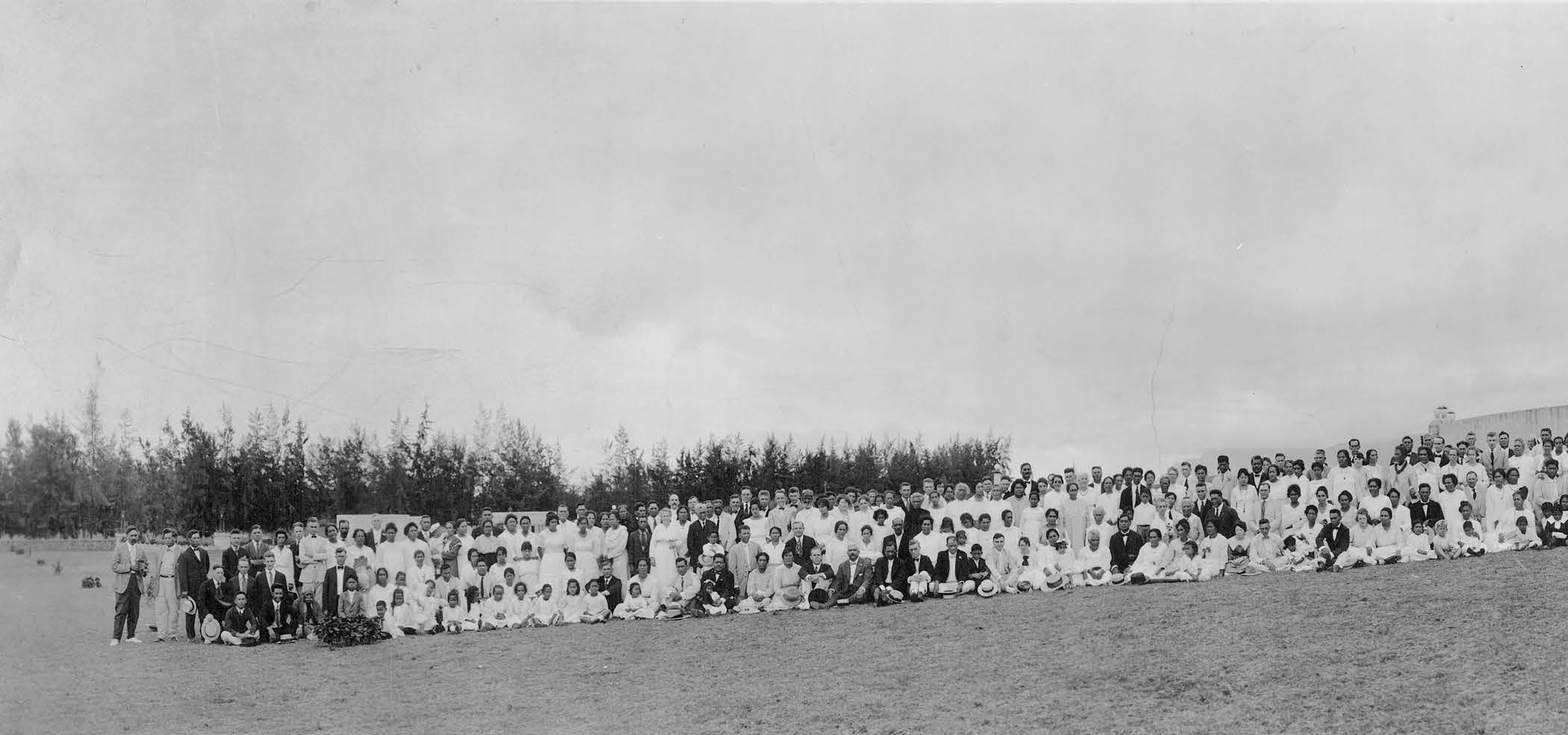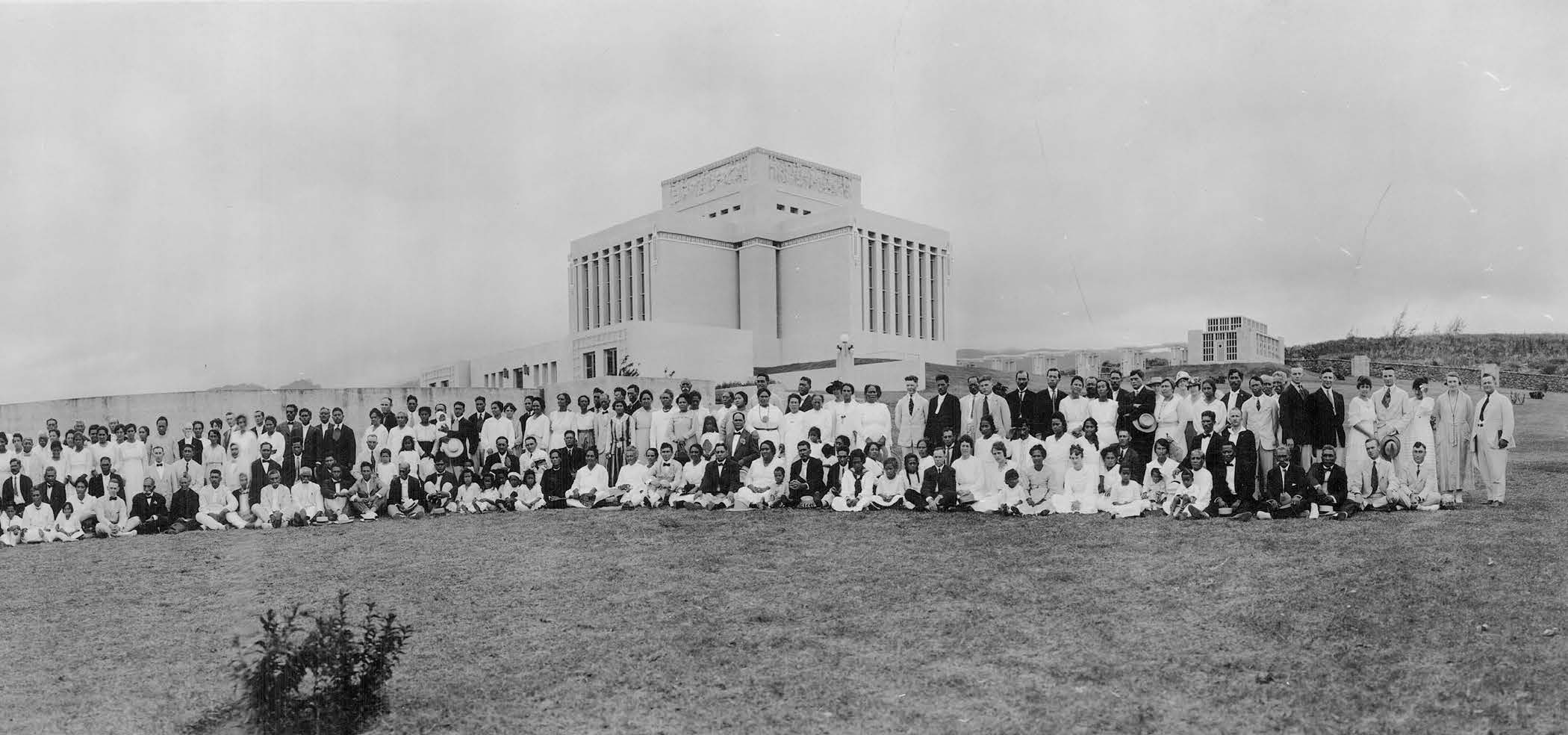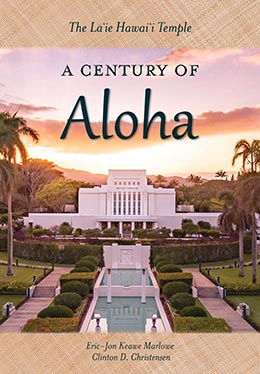Preface
Eric-Jon Keawe Marlowe and Clinton D. Christensen, "Preface," in The Lā'ie Hawai'i Temple: A Century of Aloha (Religious Studies Center, Brigham Young University; Salt Lake City: Deseret Book, 2019), vii–xvi.
Aloha
Aloha reflects an early Hawaiian concept most commonly understood as love, affection, compassion, and mercy.[1] Some variant of the word can be found in all Polynesian languages, and its meaning is believed to have originated in the warmth of family. Further, this love of family (aloha o ka ‘ohana) was not limited to the living, but extended to ancestors as well. Beyond the family, the notion of aloha defined the deepest level of friendship (hoaaloha). And when aloha was extended through generosity toward others, including the stranger, the circle of aloha expanded.[2]
 Island Saints in front of the Laie Hawaii Temple in July 1920. Courtesy of Church History Library.
Island Saints in front of the Laie Hawaii Temple in July 1920. Courtesy of Church History Library.
When Christianity arrived in Hawaiʻi, the rich meaning of aloha was ready to give expression to such teachings as compassion, kindness, charity, love of family, and ultimately the love of God (aloha o ke Akua). As the Reverend Abraham Akaka explained, “Aloha is the spirit of God at work in you and in me and in the world, uniting what is separated. . . . It is the unconditional desire to promote the true good of other people in a friendly spirit, out of a sense of kinship. . . . The spirit of Aloha loves even when the love is not returned. And such is the love of God.”[3] On a spiritual level, aloha is an invocation of the divine nature within each of us.
The word aloha is used as a greeting or as a farewell, both conveying deep regard. It has been said that aloha is farewell with a prayer for a sweet reunion. It is the light within that says, “You are my brother. You are my sister. I honor and respect you for who you are, a child of God. Welcome to my life, my world. Aloha.”[4]
Yet to some, aloha is indefinable with words alone—to be understood, it must be experienced. Aloha is the essence of relationships in which each person is important to every other person. Aloha is a way of living and of treating each other with love and respect.
It is aloha for family, ancestors, humanity, and the divine that has drawn so many to the Laie Hawaii Temple. And it is the bonds of aloha that the Laie Hawaii Temple has been making eternal for one hundred years.
The Purpose of Temples
“Members of The Church of Jesus Christ of Latter-day Saints regard the temple as the house of the Lord—the most sacred place on earth.”[5]

In the Old Testament, the tabernacle served as a kind of “portable temple” for generations (Exodus 26–27; 40:35). Then came fixed temples such as the temple of Solomon (2 Chronicles 5; 7:1–2) and the temple of Zerubbabel (Ezra 3; 6:3). During his earthly ministry, Jesus Christ was often found in the temple (Luke 2:40–49; Matthew 21:10–14). There he taught, healed the sick, and defended the temple’s sanctity. In the Book of Mormon, the people of Nephi built a temple similar to that of Solomon’s (2 Nephi 5:16), and King Benjamin gathered his people to the temple to teach and exhort them (Mosiah 2–4). Later, when the resurrected Lord visited the Nephites, they were gathered at the temple (3 Nephi 11:1–10). Though details vary, these ancient temples were all places where people sought to draw closer to God, participate in sacred ceremonies, and deepen their commitment to follow him.[6]
After the Church of Jesus Christ was reestablished in 1830, the Lord again commanded his people to build temples (Doctrine and Covenants 88:119; 95). Notably, the first building of worship constructed by the Church was not a chapel, but a temple in Kirtland, Ohio, completed in 1836.[7] After settling in the Salt Lake Valley, the pioneer Saints constructed four temples in Utah, including the renowned Salt Lake Temple. Remarkably, the temple in Lāʻie, Hawaiʻi, came next, the first built in the twentieth century.
Temples are holy places of worship with the principal purpose of providing ordinances.[8] One such ordinance is called the endowment and “consists of a series of instructions and includes covenants to live righteously and follow the requirements of the gospel. The endowment focuses on the Savior, His role in Heavenly Father’s plan, and the personal commitment of each member to follow Him.”[9] Another temple ordinance is celestial marriage. In this ordinance “husbands and wives are sealed to each other and children are sealed to their parents in eternal families. This means that if we are faithful to our covenants, our family relationships will continue for eternity. In addition to receiving these ordinances for ourselves, we can receive them for our deceased ancestors. In this way, people who died without receiving essential ordinances such as baptism and confirmation, the endowment, and sealing have the opportunity to accept these ordinances.”[10]
Those who enter the temple must be worthy, which means that they keep the commandments and are prepared to make and keep sacred temple covenants.[11] And “obedience to the sacred covenants made in temples qualifies us for eternal life—the greatest gift of God to man.”[12]
President Thomas S. Monson, who rededicated the Laie Hawaii Temple in 2010, summarized that “in the temple, the precious plan of God is taught. It is in the temple that eternal covenants are made. The temple lifts us, exalts us, stands as a beacon for all to see, and points us toward celestial glory. It is the house of God. All that occurs within the walls of the temple is uplifting and ennobling.”[13] And in another address President Monson concluded: “The [temple] prepares all who enter to return homeward—homeward to heaven, homeward to family, homeward to God.”[14]
A Unique Story Fueled by Faith
All Latter-day Saint temples throughout the world serve the same valuable purpose, and the ordinances and covenants are the same in each. Each temple is welcoming, open, and available to any qualified member of the Church. Yet each temple has its own unique story to tell.
In many ways the Laie Hawaii Temple may be considered a “pioneer temple.” By following the iconic Salt Lake Temple in order of dedication, the Laie Hawaii Temple became the Church’s fifth in operation and the only temple then functioning outside Utah.[15] It was also the first temple built outside North America,[16] a distinction it owned for over thirty-five years.[17] With the only other operating temples located some three thousand miles away in the north-to-south corridor of the Rocky Mountains, for decades the Laie Hawaii Temple served as the closest temple longitudinally for half the planet.[18] With such reach, this temple was one of the first to accommodate large numbers of patrons from different cultures speaking different languages. This level of multicultural, multilingual integration would not be seen in other temples for several decades.[19]
As the Church shifted from encouraging members around the world to gather to the Zion in the Intermountain West, emphasizing instead the need for members to build up stakes of Zion in their own homelands, the Laie Hawaii Temple was among the first temples that were “brought to the people.”[20] It was an early physical symbol of the resolve, and some might say audacity, of a relatively young and provincial church[21] to take the fulness of the gospel, realized only in temples, to every nation, kindred, tongue, and people (see Revelation 14:6–7).
The Laie Hawaii Temple played a role in spawning Brigham Young University–Hawaii and a world-class tourist attraction, the Polynesian Cultural Center. Over the years, the temple in Hawaiʻi and the institutions built around it have drawn millions of visitors, likely second in numbers only to historic Temple Square in Salt Lake City. The Laie Hawaii Temple is recognized internationally and has been a valuable tool for introducing the Church and its message to the world.
As interesting as such details and facts surrounding the Laie Hawaii Temple may be, behind them lies a much more significant story—a human story. Each temple, regardless of its location throughout the world, was originally built on the collective faith of individuals in a geographic area. And in the case of earlier temples like the Laie Hawaii Temple, they were also built in large measure by the hands, funds, and deep sacrifices of the Saints in those regions. Temples do not idly fulfill their purpose; they require an engine of people (e.g., a temple presidency, matrons, recorder, groundskeepers, genealogists, clothing clerks, sealers, custodians, ordinance workers, and patrons) fueled by the same faith and sacrifice exemplified by those early island Saints who made a temple in Hawaiʻi possible. It is this human story of faith and sacrifice that can invoke in us a deeper appreciation for temple worship, open our eyes to the great blessing therein, and in general bolster our faith and inspire us. And this is the ultimate hope in telling the story of the Laie Hawaii Temple.
Terminology
Because this history generally takes a chronological approach, a number of titles and names accurate in one era change as the narrative unfolds. Perhaps most noticeable is the change in the temple’s name toward the end of the book. For almost eighty years the temple was known as the “Hawaiian Temple” or the “Hawaii Temple.” With the announcement of the Kona Hawaii Temple in 1998 and the subsequent release of temple-naming guidelines by the First Presidency in 1999, the Hawaii Temple’s official name became the “Laie Hawaii Temple.” [22] Thus any mention herein of the Hawaiian or Hawaii Temple refers to the Laie Hawaii Temple.
 Gathering of Hawaiian Saints at the temple on 6 April 1922. Such faithful members have always been the lifeblood of service in the Laie Hawaii Temple. Courtesy of Church History Library.
Gathering of Hawaiian Saints at the temple on 6 April 1922. Such faithful members have always been the lifeblood of service in the Laie Hawaii Temple. Courtesy of Church History Library.
When first established in 1850, the Church’s mission in the region was called the “Sandwich Islands Mission,” later becoming the “Hawaiian Mission” and eventually the “Hawaii Mission.” To simplify this uneven transition, the names Hawaiian Mission and Hawaii Mission are used interchangeably throughout.
Today the terms Hawaiian and Native Hawaiian are reserved for describing the descendants of the indigenous inhabitants of the Hawaiian Islands. In this book we have elected to use Hawaiian Saints, Hawaiian members, and similar terms with that understanding in mind. When referring to the general membership of The Church of Jesus Christ of Latter-day Saints in Hawaiʻi, we have employed all-inclusive phrasings such as “Church members in Hawaiʻi.” In maintaining this distinction, we hope to promote both clarity and respect. A similar approach is taken with the indigenous inhabitants of other island nations and their descendants (e.g., the Māori of New Zealand and the Samoan, Tongan, and Tahitian peoples).
The temple visitors’ center, located at the front entrance to the grounds since the temple’s construction, was originally called the temple “Bureau of Information,” the “Visitors’ Bureau,” or the “Bureau” for short. Church use of the term visitors’ center did not become common until the 1960s. Thus the first three terms are used in this book until the early 1960s, and thereafter visitors’ center is used.
The Church College of Hawaii, established in 1955, was known as such until 1974, when its name was changed to Brigham Young University–Hawaii (BYU–Hawaii).
Finally, the official name “The Church of Jesus Christ of Latter-day Saints” is most often referred to as “the Church” throughout the text. However, reference to the Church as “Mormon” or “LDS” is maintained within direct quotation
Notes
[1] Mary Kawena Pukui and Samuel H. Elbert, Hawaiian Dictionary: Hawaiian-English, English-Hawaiian, rev. ed. (Honolulu: University of Hawaiʻi Press, 1986).
[2] For a discussion of the early concept of aloha, see George Huʻeu Sanford Kanahele, Ku Kanaka Stand Tall: A Search for Hawaiian Values (Honolulu: University of Hawaiʻi Press, 1992), 467–83.
[3] Rev. Abraham K. Akaka, “Aloha ke Akua,” Hawaiʻi statehood address, Reverend Akaka Ministries Foundation, Honolulu, 13 March 1959, http://
[4] R. Lanier Britsch, “The Purposes and Blessings of the Polynesian Cultural Center,” Brigham Young University–Hawaii devotional, 25 September 2003, https://
[5] Temples of The Church of Jesus Christ of Latter-day Saints, special issue of the Ensign, October 2010, 3.
[6] “Why Latter-day Saints Build Temples,” https://
[7] Royden G. Derrick, Temples in the Last Days (Salt Lake City: Bookcraft, 1987), 30.
[8] Gospel Topics: Temples, https://
[9] Gospel Topics: Temples, https://
[10] “Commonly Asked Questions,” Ensign, October 2010, 79.
[11] Gospel Topics: Temples, https://
[12] Russell M. Nelson, “Prepare for the Blessings of the Temple,” Ensign, October 2010, 42.
[13] Thomas S. Monson, “Blessings of the Temple,” Ensign, October 2010, 13.
[14] Thomas S. Monson, “Days Never to Be Forgotten,” Ensign, November 1990, 67, 70.
[15] The Cardston Alberta Temple was announced on 27 June 1913 (more than two years before the Laie Hawaii Temple was announced) and dedicated on 26 August 1923 (almost four years after the completion of the temple in Hawaiʻi). President Joseph F. Smith announced the building of a temple in Hawaiʻi in the October 1915 general conference; it was dedicated in 1919.
[16] Hawaiʻi was an incorporated territory of the United States from 12 August 1898 until 21 August 1959, when it became the fiftieth US state.
[17] The Bern Switzerland Temple was the next temple dedicated outside North America, on 11 September 1955.
[18] The three temples dedicated after the Laie Hawaii Temple (the Cardston Alberta, Mesa Arizona, and Idaho Falls Idaho Temples) were all in the same north-to-south corridor.
[19] William M. Waddoups, first president of the Laie Hawaii Temple, wrote, “It is, so far as I know, our pleasure to have done the first work for any living persons of the following races, in any Latter-day Saint temple: Chinese, Japanese, and Korean.” William M. Waddoups, “Hawaiian Temple,” Improvement Era, April 1936, 227. Further, the Laie Hawaii Temple likely provided some of the first temple work for native members of such countries as the Philippines, the Marshall Islands, and Guam. And before the proliferation of temples in the Pacific and Asia, temple groups from New Zealand, Japan, and Korea made regular trips to the Laie Hawaii Temple. See chapter 12 herein.
[20] “Interesting Facts,” Temples of The Church of Jesus Christ of Latter-day Saints, https://
[21] Total Church membership was approximately four hundred thousand in 1916. See US Bureau of the Census, Census of Religious Bodies, 1916, part 2 (Washington, DC: Government Printing Office, 1919), 334, https://
[22] “Temples Renamed to Uniform Guidelines,” Church News, 16 October 1999.
